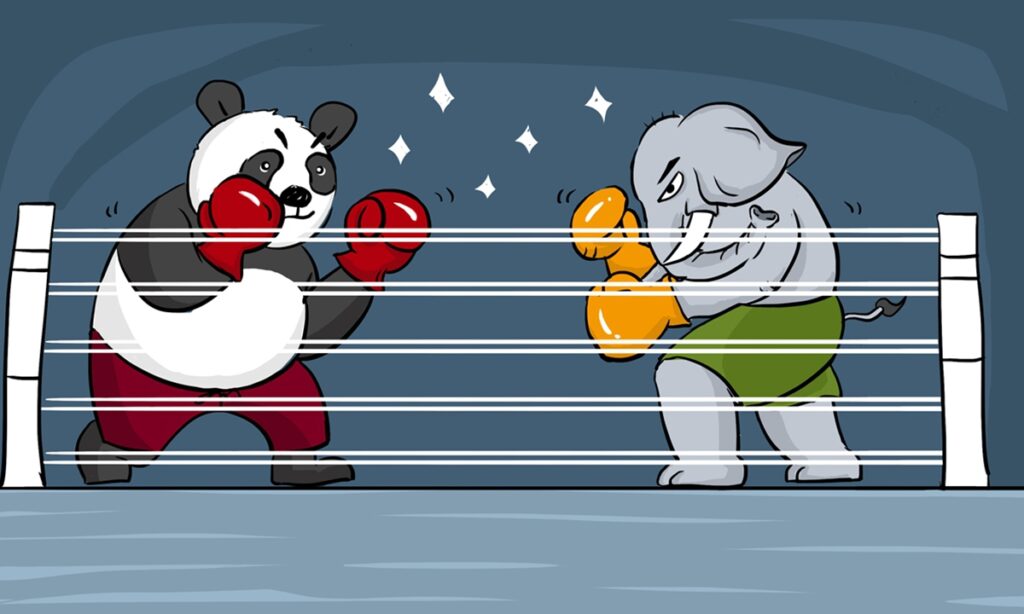China India Photo: GT
By Song Zhongping
Indian troops again illegally crossed the Line of Actual Control (LAC) on Monday, and outrageously fired warning shots at Chinese border patrol soldiers. Chinese troops were “forced to take corresponding countermeasures” to stabilize the situation, according to Zhang Shuili, spokesperson of the Chinese People’s Liberation Army (PLA) Western Theater Command.
India has abandoned the agreement that restrains Chinese and Indian soldiers from using firearms at border. Indian side believes that by not using firearms, its army is at a disadvantageous position. Thus, it may want to resort to firearm to maintain Indian army’s combat capability and nibble away at Chinese territories.
After the China-India Galwan Valley clash in June, India has given its army “complete freedom of action” to commanders deployed along the LAC, which means they are no longer bound by restrictions on using firearms. Such an irresponsible move has significantly escalated the tense situation.
Now that Indian troops have fired shots, the two sides’ consensus on managing the crisis no longer exists. The Chinese and Indian armies mainly used cold weapons or physically clashed in their previous disputes. But now, with the use of firearms, the border situation will continue to worsen. India has unilaterally violated the two sides’ border consensus.
If Indian troops use guns, the Chinese troops will be forced to use them as well. Indian troops entered the Chinese side of the LAC, and Indian media said its soldiers have seized two commanding heights on the southern bank of Pangong Lake. These moves are serious provocations over China’s territory, and they are doomed to be countered.
After India suffered a crushing defeat in the 1962 China-India border war, Indian troops have always wanted to take their so-called revenge. India has strengthened its combat capability in mountain warfare, and has acquired American-made and Russian-made equipment. Its combat capability should not be underestimated. But the problem is, Indian troops do not have enough systemic and joint combat capabilities, which restricts its real combat capability.
The US is India’s biggest supporter. If a military clash or a war occurs between China and India, the US is more than happy to see it. The US will woo India and turn it into one of its allies, breaking India’s diplomatic principle of non-alignment. Meanwhile, the US will coerce the international community to support India and resist China, taking the opportunity to build Washington’s military and political alliances. What makes the US even happier is that it can export all sorts of advanced weapons to India to make handsome profit. The US is also likely to provide military intelligence to India.
Despite US support to India, the PLA is capable of defeating Indian army. China claimed victory in the 1962 war, which should be a lesson for India. Moreover, the military capability of the PLA is not what it used to be decades ago. Now, the PLA is a modern one with informatization capability, systematic combat capability and joint combat capability.
Suppose India’s fighter jets or tanks are hit. Due to limited production capability of India, it needs to purchase from abroad. In PLA’s case, the PLA can quickly make up for its losses in a military clash, thanks to China’s strong military industry production capability. But it is impractical for India, a half-agricultural and half-industrial country to recover soon.
Furthermore, if India purchases equipment overseas at critical junctures, it will pay a high cost and wait for an uncertain period, making its combat capability hard to sustain.
For the PLA, the problem is not how to defeat India, but how to maintain peace and stability at the border. As both are members of the Shanghai Cooperation Organization, the two countries should work on co-existing peacefully and managing conflicts. India should not make provocations. If it does, history will repeat itself – the Indian army is bound to be defeated. Global Times




